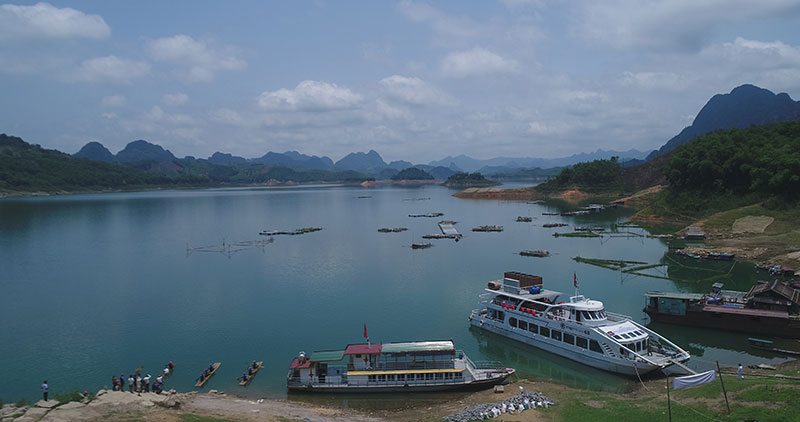
(HBO) - According to the Master Plan for the development of the National Resort of Hoa Binh Lake until 2030, Ngoi Hoa subdivision is located in Ngoi Hoa commune (Tan Lac). This is the central section of the tourist area of Hoa Binh Lake. The main tourist activities are often taken place there and there is a symbolic space of the tourist area of Hoa Binh Lake.
The subdivision has an area of 1,200 ha, which is planned to build eco-resorts, hotels, restaurants, thematic parks, outdoor sports areas, water sports and ecological farms combined with resorts along the lakeside.
Up till now, seven investors have been studying, surveying and invested with a total area of 1,714,215 ha in Ngoi Hoa commune. In particular, the People's Committee of the province has decided to invest in 3 projects. They include the Project of Hoa Binh Lake resort and the eco-tourism with the total use of land of 304.9 hectares and the registered investment capital of 800 billion VND; The Project of Ngoi Hoa eco-tourism area with the total use of land of 115,355 hectares and the registered investment capital of 474,719 billion VND and the Project of V’Star - Ngoi Hoa eco-tourism with the total use of land of 183.55 hectares and the registered investment capital of 125 billion VND.
There are 2 projects that are preparing for the investment, namely the project of the ecological tourist area of Sword Lake - Song Da and the project of Ho Tien - Ngoi Hoa eco-tourism resort. Two projects are in the process of research and survey. They are the project of the resort, the eco-urban, the sports and entertainment area in Thung Nai - Hoa Binh and the project of Hoa Dao valley eco-tourism.
If the projects mentioned above are soon implemented and the upgrading of the Road 435 from Hoa Binh City to Ngoi Hoa Bay connecting to the core zone of Tourist Area of Hoa Binh Lake with the total length of 21.18 km along with Ngoi Hoa wharf is completed in 2020, Ngoi Hoa Bay tourist destination will have a high-quality resort with 4-star hotels, and luxurious resort and entertainment services. Ngoi Hoa Bay will become the tourism center of the Tourist Area of Hoa Binh Lake, attracting a lot of tourists and it will be one of the important tourist destinations, making the Tourist Area of Hoa Binh Lake soon meet the national tourism criteria.
Located just a 20-minute drive from Hoa Binh City, Ora Hill Farmstay & Glamping Hoa Binh is a captivating new destination nestled in Mo hamlet, Bình Thanh commune, Cao Phong district. Combining farming with leisure, this tranquil retreat is perfect for those seeking balance, joy, and an immersive experience in the expansive beauty of nature.
Muong Bi - Tan Lac is renowned as one of the four famous Muong regions in Hoa Binh province. Blessed by nature with a favourable climate and stunning landscapes, Tan Lac holds great advantages for tourism development. The local tourism industry has made remarkable strides in recent times thanks to the attention and support from the local authorities and sectors.
With its strategic location, well-developed transport network, and diverse soil and climatic conditions, Hoa Binh is emerging as a must-visit destination in Vietnam's northwestern tourism corridor. The province boasts numerous attractions, including the Kim Boi hot springs (Kim Boi district), the Dau Rong cave complex (Cao Phong), the Mai Chau valley (Mai Chau), and the iconic Hoa Binh hydropower plant.
The northern mountainous province of Hoa Binh has been listed among the 71 most beautiful places to visit worldwide by the prestigious US travel magazine Condé Nast Traveller.
Hoa Binh province’s rich natural and cultural resources position it as a prime location for developing community-based tourism (CBT). In recent years, support from central and provincial policies, as well as assistance from non-governmental organisations, have encouraged local ethnic minority and mountainous communities to actively engage in the sector.


